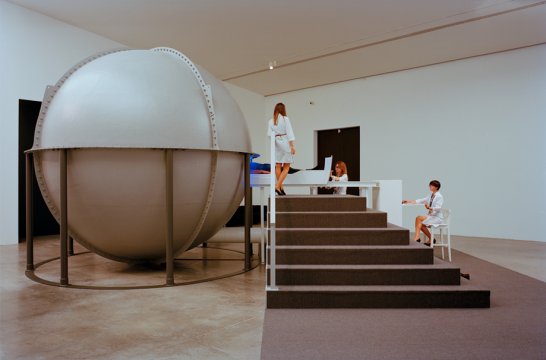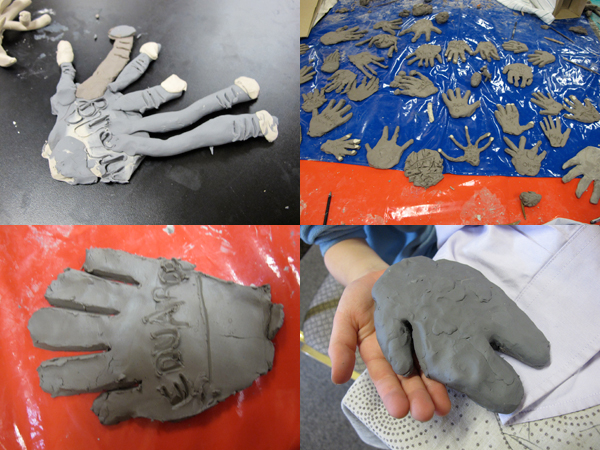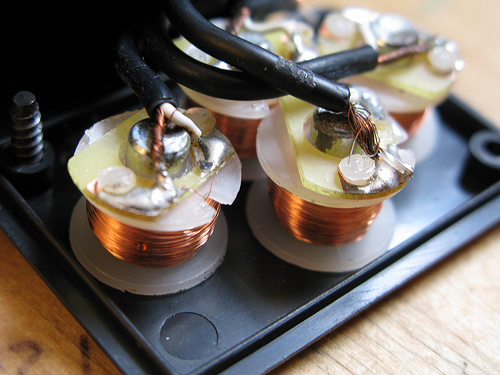This research looked at how we respond to the observation of actions and how the context affects our neural processing of that action. I was fascinated to learn simply by observing an action with an object that can be potentially used for an action - such as a potato peeler - the brain seems to simulate this action. But what happens when we observe an object being used for an action in an unusual context? Or what happens if we see an object being used for an unusual action, perhaps even in an unusual space. The experiments used videos of a person performing a task with specific objects in specific contexts such as cracking and egg into a bowl in the kitchen. and was then repeated in
Tag: psychology
Rubber hands ‘feel’ touch that eyes see
The first report on the Rubber Hand illusion. Published in Nature in 1998 by Matthew Botvinick, and Jonathan Cohen of the Department of Psychiatry, University of Pittsburgh... "We report here an illusion in which tactile sensations are referred to an alien limb. The effect reveals a three-way interaction between vision, touch and proprioception, and may supply evidence concerning the basis of bodily self-identification." "It has been proposed that the body is distinguished from other objects as belonging to the self by its participation in specific forms of intermodal perceptual correlation7,8. Subjects in our first experiment who referred their tactile sensations to the rubber hand also consistently reported, in both sections of the questionnaire, experiencing the rubber hand as belonging to themselves. Indeed,
James Turrel – Light Reignfall
[vimeo 75419053 w=640 h=360] James Turrell's Light Reignfall @LACMA - Andrew van Baal James Turrell's Light Reignfall Light Reignfall is a work from his series of perceptual cells, inside the participant is exposed to a uniform homogenous field of modulated light. A combination of sensory overstimulation, yet deprived of recognisable forms or space, hallucinatory effects are experienced. “Assisted by an attendant, an individual viewer enters a spherical chamber on a sliding bed. A program of saturated light (operated by a technician) surrounds the viewer for twelve minutes, allowing the visitor to experience the intense, multi-dimensional power of light and the complex seeing instrument of the human eye.” "James Turrell (b. 1943, Los Angeles), a key artist in the Southern California Light and Space movement
What is Somaesthetics?
The work of Olafur Eliasson and Carsten Höller are prime examples of artists working with perceptual systems in which the viewers become active participants. This could be called 'Perceptual Art' but this term is not widely used, and it has been in a limited sense referring to artwork using optical illusion. In light of this, searching for an umbrella term for artwork that uses experiential and multisensory elements, I stumbled across the term 'Somaesthetics' "an interdisciplinary field whose roots are in philosophical theory, somaesthetics offers an integrative conceptual framework and a menu of methodologies not only for better understanding our somatic experience but also for improving the quality of our bodily perception, performance, and presentation " [1] first coined by Richard Shusterman in 1996 There is
God Helmet
Neurologist Michael Persinger created the God Helmet, an actual helmet modified with electrical coils that can create electromagnetic fields in the wearer's temporal lobes that induces "religious" experiences in the people who put it on. "This is a device to investigate whether religious, spiritual, and mystical experiences had a natural rather than a supernatural source. He speculates that we are somehow programmed so that they can generate religious experiences via our brain's internal processes." I was interested in this experiment because of its use of sensory deprivation and the fact it would be relatively easy to recreate [see my DIY neurostimulation attempt 2009] for my Enki project. My plan was to drive it with frequencies generated by my electric fish [a low
Auditory illusion
Diana Deutsch developed some fascinating auditory illusions. These include the phenomenon of 'speech to song' whereby repeating loops of spoken word suddenly begin to sound like a song. In another illusion, 'phantom words' new words emerge from repeating fragments of words. To experience these all you need are headphones as the a stereo effect is essential, here is the link to her work.… Speech to song http://deutsch.ucsd.edu/psychology/pages.php?i=212 Phantom Words http://deutsch.ucsd.edu/psychology/pages.php?i=211 https://www.youtube.com/watch?v=EWzt1bI8AZ0 A nice example of sine wave speech from Joe Banks [Disinformation] has written about psychoacoustics in his book https://rorschachaudio.com/ I was lucky to meet him at The Sensorium of Animals workshop. "The McGurk effect" is a perceptual illusion that mixes a sound with the visual cue of a different sound, We see the mouth move and hear/see a mismatched sound, check out what happens... https://www.youtube.com/watch?v=aFPtc8BVdJk https://www.youtube.com/watch?v=7uHDMc4TEU8 This
Acupuncture, brainwaves, and electric fish
Some documentation from a day working with Greg Byatt developing a system to work with the IBVA [Brainwave visulisation] interface. Such as attaching the Electric signal discharge output from the Electric Fish to acupuncture pads placed on our arms, to see if we could perceive the signal and also seeing how the fish behaved. No conclusive results. More time needed! In preparation for the next Enki event, we spent the day testing the neuro-graphic interface; as an experiment, we patched a strong frequency via MIDI to a MAX patch so our brains were modulating all kinds of strange sounds. Later this will combine with the Enki interface as a form of feedback. In this image you can see the graphics of the brain activity and
Enki Manchester Science Museum
Some of the early experiments for the Enki project at Museum of Science and Technology Manchester 2007... We recorded brainwave data and monitored the behaviour of the electric fish during the experiment. The electrical activity of the fish is experienced as sound and light via ENKI (a stroboscopic high frequency led placed close to eyelid) and the natural binaural frequencies produced by the interaction and communication between Black Ghost Knife fish. The participant's bio-electric field was connected to the aquarium allowing the fish to sense a human (bio)electric image or presence. Museum of Science and Industry Manchester, 7th October 2006
My experience of the ‘strange face illusion’
I had read about this experiment by which staring at one's own reflection in a mirror in a darkened room for some time, can induce vivid hallucinations. For purposes of research, I had to try it. I found my bathroom could meet the following requirements... "... a quiet room dimly lit by a 25 W incandescent light. The lamp was placed on the floor behind the observer so that it was not visible either directly or in the mirror. A relatively large mirror (0.5 m60.5 m) was placed about 0.4 m in front of the observer. The luminance of the reflected face image within the mirror was about 0.2 cd mÿ2 and this level allowed detailed perception of fine face traits but
Inverted vision experiments
An early experiment in 'perceptual plasticity' was conducted by Psychologist George Stratton in1896. He used his inverted vision goggles, over a period of 8 days, and over time adapted to the point where he was able to function normally. When the glasses were removed, it took some time for him to adapt back to seeing the world as normal without them. See also A lesser-known experiment over three days in 1899 used a set of mirrors to view his whole body as if tilted by 90 degrees. He describes interesting motor control anomalies and even an experience which he describes as an 'out of body experience'. Currently, I am searching for more information and documentation on this experiment. Theodor Erismann (1883-1961) and Ivo Kohler
Rubber-hand illusion experiment
As part of my research into perceptual illusions, I looked into The ‘Rubber Hand Experiment’. This is a classic low tech experiment that can help us "understand how sight, touch and “proprioception” the sense of body position, combine to create a convincing feeling of body ownership, one of the foundations of self-consciousness (Nature 1998, vol 391, p 756 )”. Recent studies have gone on to experimentally induct of out of body experiences or create body swap illusions. See the work of Henrik Ehrsson and Olaf Blanke. [see link http://www.eurekalert.org/pub_releases/2007-08/ucl-foe081407.php ] I invited some psychologists to the studio [including Lizzi Lewis of BEAM Lab and Paul Sermon] who I have expertise in this area, they brought presentations and some kit to
Clay hand experiment #1
Working again with Lizzi Lewis of BEAM Lab and Manchester Science Museum we developed a workshop based on the 'Rubber Hand Experiment'. As we had to work with a large number of people and we didn't have funding to get loads of rubber hands. So we made the hands in the workshop with clay and used gloves full of different materials, sand, gel, lentils, etc. This had some interesting outcomes, that warranted further research... As you can see the hands were diverse in form, for the illusion to be effective the hand does not need to be true to life necessarily. Some hands were made purposefully alien for experiments and seemed to work effectively. I wondered if participants are more likely
DIY Neuro stimulation
Reposted from my other blog 2009... I think the discussion around Michael Persinger's God helmet experiment was really interesting. I had to act on this and investigate the realm of experimental psychology further. I got in touch with him to ask some questions about the technology and the experimental process. I asked if I could make an array electromagnetic coils with oscillating magnetic field could generate similar effects. Which he seemed to think was feasible. I decided to make a modified version of the god helmet to work with my Enki interface. Here is a view my DIY neuro-stimulation device there are 4 coils which oscillate with magnetic frequencies, I have been using MAX MSP to drive these using electrical pulses derived from the
Enki interface 2006-2013
This project formed the basis for my PhD proposal. Initially, it was an investigation into the behaviour of electric fish, which have the ability to navigate and communicate using electro-perception. I investigate ways in which to communicate and interact with them. , I soon started to become interested more widely in perceptual and psychological experiments with humans; themes of interconnectedness, extending sensory perception. More specifically a notion of the 'body as electric image'. " The ENKI project was developed through an Arts Council, International Artists Fellowship, Pepiniere programme, Paris, with Centre National de la Recherche Scientifique (CNRS) France in 2006. It has been shown in the UK Europe including, Dutch Electronic Arts Festival, NL, CAAC, Seville, Spain 2007. International Festival of Art /Science
ENKI exhibition at Kapellica Gallery
10/2012– 01/2013 Enki [Solo show] Kapellica Gallery, Ljubljana, Slovenia Enki experiment 5 Possibly the final showing of the ENKI project ENKI is a series of experiments in bio-interfacing between humans and certain types of Electrogenic Fish .. Ultimately this is achieved through psycho-acoustic audio and visual entrainment as a means of modulating human emotional state. During this process, bio-electrical activity is monitored and used as a means to create a feedback loop between organisms. The research aims to study the interaction between tiny bio-electrical fields of both species [human and fish] specifically the way in which these fields modulate and the means of controlling them. It also aims to discover if it is possible to create a harmonious state of interaction that can
Amplitude Modulation Workshop
I met Martin Howse in 2009 when he invited me to do a workshop for his micro research series in Berlin. At the time he had a fantastic apartment with a large garage space for a studio. The large table at its centre became sprawled with electronics by the end of the day. I had the opportunity to take a look at some of his projects, wonderful hand-drawn circuits burnt and encrusted that looked more like remnants from some other device of unknown function. For this workshop we investigated Amplitude Modulation, turning light into sound, use of the LM chips as an amplifier and using light sensors as an input, and making LEDs and lasers transmit sounds and signals through light





